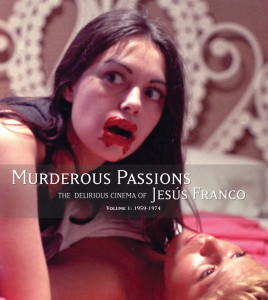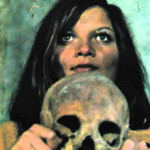THE DIABOLICAL DOCTOR FRANCO
Murderous Passions: The Delirious Cinema of Jesus Franco
Stephen Thrower with Julian Grainger
Strange Attractor Press
432 pages + 32 pages of colour
£40 / £50
Stephen Thrower casts a languorous zoom lens at Jess Franco’s life and career in his new book, Murderous Passions.
With Murderous Passions, Stephen Thrower has helped to place the late Jess Franco’s films in a proper context for further study by those who find themselves ensnared in the ludicrously prolific Spanish filmmaker’s vast web. Over the course of over 400 large format pages, he provides what we might reasonably surmise is all extant – or at least printable – information on Jess Franco’s first sixty three feature films. His subsequent 108 features are to be covered by a second levitra mit rezept 10 mg preise volume. There are also many never-before-seen photographs. Even if the book were not excellent and definitive (and it certainly is) the reference value of the listings and the beauty of the photographs would make it a must-own for any Francophile.
Above all else, anyone who loves Franco must be grateful for Thrower’s insightful understanding and articulation of Franco’s worth as a filmmaker. It’s no easy matter to communicate the appeal of Franco’s cheap, illogical oeuvre to those who don’t “get it.” Typically the non-believer wonders why in the hell anyone would spend time watching one of Franco’s movies, let alone scores of them. It must be all the tits, they think. How can we communicate that it is and it isn’t? That it’s so much more? Well, now we can just produce our soon-to-be dog-eared copy of Murderous Passions and turn to one of Thrower’s beautifully written essays. We may assume that much of Franco’s greatness exists outside the explainable sphere. Thrower gets closer to the magic than we might have thought possible with observations like these:
“The subtle gradations of his style occur across a broad spectrum, with anarchic inspiration at one extreme and short-tempered carelessness at the other. Watching just a single film gives a burst of raw signal that can seem like pure noise, but see enough of them and the oscillation builds and builds, until a unique psychosonority can be heard.”
Yo, I feel that. Also:
“I believe that the dominant structural hallmark of Franco’s cinema is his manipulation of time, in particular time as it’s experienced through desire. It’s widely agreed that the speed of time is not experienced as a constant: it can seem to ‘fly’ or slow down depending on our situation. During sexual arousal adrenaline is released into the body and this dilates the blood vessels, increasing the flow of blood and making time seem to run more slowly as the ‘internal’ pace speeds up. Meanwhile the neurotransmitter phenylethylamine triggers the release of dopamine in the pleasure centres of http://www.spectacularoptical.ca/2021/03/propecia-for-women-hair-loss/ the brain, causing feelings of bliss and excitement. What Franco seeks to do in a great many of his narcotic, hallucinogenic sex scenes, is to reproduce this compact of sensation by means of camera technique, editing and music.”
This is a movie book on a higher level than just idle fandom. Thrower is illuminating levels of value in Franco’s art with the kind of lucidity Franco deserves.
On the controversial matter of Franco’s zoom lens use (a tool he became a consummate master of, especially in his early ‘80s period), Thrower is inspired:
“Once we learn to regard the zoom as something with charm in and of itself, and not just a labour-saving device, it begins to speak to our imaginations. And it’s the notion of imagination that conveys my final argument in favour of Jess Franco’s zooms; while the human eye cannot zoom, the human imagination certainly can. In everyday erotic experience our imagination zooms, levitra 20mg side effects even as our eyes simply look here or there. The desire to swoop closer, to penetrate the distance between ourselves and the object of our desire, the rush of arousal that glides us through space in our imaginations until we’re no longer gazing flatly from a distance, but intimately participating in the imaginary flesh of the other; this is where the zoom assumes a powerful symbolic or, if you like, pataphysical function; it is the fantasist’s friend, and – pun intended – the voyeur’s tool par excellence.”
Refreshingly, Thrower does not feel the need to go neuter in his analysis. We aren’t given any puritan lines about Franco’s films. He’s not like the art teacher who tells us that, say, Modigliani’s nudes are not intended to be looked at sexually. Franco’s viewpoint and value as a filmmaker has everything to do with his views on sex. Thrower writes knowingly and respectfully about Sade, and the ways Franco (and his sometime writer-producer Harry Alan Towers) distort Sade’s work on occasion. He also does not shy away from criticizing treatment of rape and sexism where it occurs, mainly, but not always in the films produced by international man of mystery Towers.
Thrower paints a picture of Franco as a man working at top speed, sometimes completing a film on a Saturday and starting another on Monday morning. In Franco’s case, post-production (at least in the ‘70s) was almost always completed by someone else, working from a rudimentary outline. Even dialogue was often left to a post production supervisor to work out. These are the kinds of details that can enrich and change a viewer’s experience, even of films he or she has already seen.
Each film listing contains full cast and crew information, filming dates and locations, comparisons of multiple versions (if any), music listings, a whole dossier of other factual information and a review of the film. Interestingly, for one who clearly loves Franco’s films, Thrower does not go easy on their flaws in his reviews. It’s all in proportion to his other methods though. If Franco is to be treated with respect, his works must be viewed and appreciated with critical rigor. Thrower’s reviews are skillfully written and often funny.
Murderous Passions is a perfect atlas for anyone wishing to venture into Franco’s labyrinth of sex, voyeurism, pulp sadism, mind control, mannequins and pussy zooms. It’s also a book that helps to lay a solid foundation for the appreciation the finer aspects of Franco’s art. It sets up the tripod for a fresh look at all of Franco’s work and the principles of freedom and joy that make it so meaningful to those of us who can detect the beautiful contours in Franco’s furiously drawn lines. This is the Jess Franco book. Or at least volume one of it. Thrower promises volume two next year.

 August 18, 2015
August 18, 2015  No Comments
No Comments








